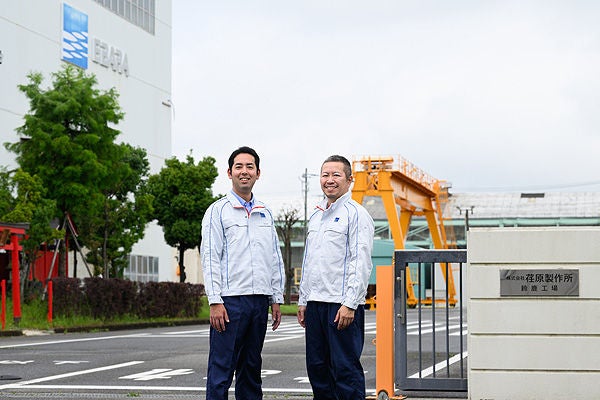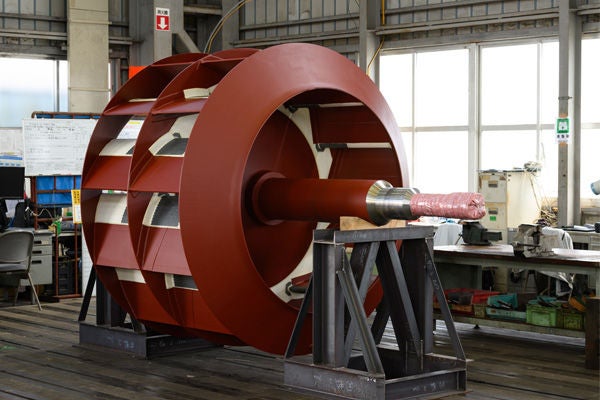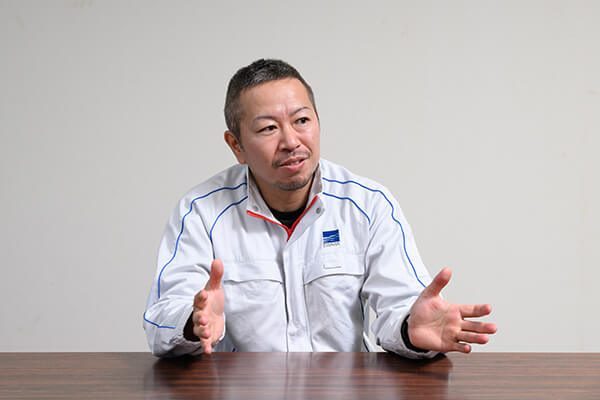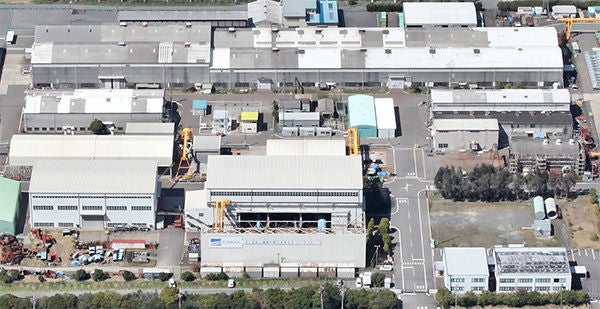Ebara Wind Machinery, which manufactures blowers for industrial use, has been working on a project for more than two years to drastically improve the technology of welding, which is an important process in manufacturing. This initiative was carried out in collaboration with the Ebara Manufacturing Technology Advanced Center (EMTAC), a base that supports manufacturing throughout the Ebara Group, and members of the Ebara Wind Machinery* of the Ebara Group.
What kind of results did they achieve? Kenta Uyama, a member of EMTAC and a member of the Prototype and Site Collaboration Promotion Section, Manufacturing Technology Development Department, Production Process Innovation and Quality Assurance Management Department, and Yusuke Masuya, Manufacturing Department, Suzuka Plant, Ebara Wind Power Machinery, who participated in this project, looked back.
Evolving welding, which is indispensable for manufacturing
EMTAC and Ebara Wind Machinery, more than 2 years of activity

Heat treatment process reduced by 80%. The number of people who have acquired qualifications has also increased.
What are these initiatives?
A wide range of people thought about the future of welding in the "Welding Technology Management Office"
― How did you start your activities to improve your welding skills?
Uyama : In January 2022, an organization called the "Welding Technology Management Office" was established within Ebara Wind Machinery and started. This project was launched for the purpose of solving the problems felt by the site in welding work, reviewing what has been done in the same way for a long time, and updating it to the latest version.
At that time, I was seconded to Ebara Wind Machinery's Suzuka Plant as a member of EMTAC. EMTAC, a corporate organization, supports EBARA's manufacturing across the Group. In cooperation with business divisions and group companies, we work together to solve the issues faced by each manufacturing site. My own mission was to improve my welding skills. I had been engaged in welding-related work for a long time, and I wanted to make use of it.
Against this background, I also participated as a member of the Welding Technology Management Office. Other members of the team had a wide range of occupations, including design, quality assurance, and procurement of Ebara Wind Machinery. Of course, there were many people who actually did the manufacturing in the field, and Mr. Masuya was one of them.

Production Process Innovation & Quality Assurance Department, Manufacturing Technology Development Department, Prototyping & Site Collaboration Promotion Section

Masuya : I manufacture blower impellers at Ebara Wind Machinery. The impeller rotates at high speed to create wind, and is the heart of the blower. When making an impeller, first prepare metal plates of the required shape and assemble them temporarily. Then, "welding" is performed to attach each metal plate. The parts of the two metal plates that are joined together are melted at a high temperature and joined. After welding, the finishing work involves de-de-sprinting the product or smoothing the surface with a grinder.
My usual work is not so much to specialize in welding, but to manage the entire process before and after temporary assembly and welding. The reason why I joined the Welding Technology Management Office is that the opinions of the people who do the welding itself are important, but it is also important to have a broad perspective on how to improve welding in the overall manufacturing process. There was a reason for that.
― Did you have a strong desire to "evolve welding" as a company?
Masuya : That's right. Welding is a really important technique in making our impeller. This is because industrial blowers run continuously for long periods of time, so the impeller also rotates at a high speed all the time. The impeller produced by Ebara Wind Machinery is large, with a size of 3 meters, and a large load is applied as it continues to rotate. The welded area is particularly delicate, so there is a possibility that defects will occur from that area. That's why I wanted to improve my welding skills.

Uyama : There was also a desire to make the welding work at the site as easy as possible. Welding is done at high temperatures exceeding 1000 degrees Celsius, and it is very hot because of the protective equipment. We received a strong request from the people in the field to improve the welding environment. That was also the purpose of making such improvements.
Masuya : Thinking about the future, I wanted to create a system to systematize and share welding know-how. The welding process was like craftsmanship, and each worker built his or her own know-how in his or her own mind. It had become what is called tacit knowledge. Systematization is also important when considering the inheritance of skills to young people. In the Welding Technology Management Office, we dealt with a wide range of themes.
Efforts to reduce heat treatment by 80% and achieve significant results
― What kind of activities did you carry out specifically?
Uyama : First of all, we freely discussed the problems that the site was having with welding and what we wanted to be in the future. On the other hand, we listed what we needed to do from now on and proceeded one by one.

Ebara Wind Power Machinery Suzuka Plant, Manufacturing Department, Canning Section
Masuya : We communicated our desire to do this and what we wanted to do as a site, and the entire project team thought about how to achieve this, including design and procurement.
In the two years since then, we have made many improvements, but one major one is our efforts related to the material "stainless steel". In the past, when welding a certain stainless steel, it was necessary to carry out the work of heat treatment afterwards. It is a process that puts the product in a high-temperature kiln for a certain period of time.
Uyama : The reason why heat treatment is necessary is to remove the "stress" generated by welding. In welding, the metal is melted at high heat, and then cooled down at once to make it stick together. It's like raising the temperature to 1000°C and dropping it to 200°C. Then, various forces are generated, such as the metal trying to shrink during rapid cooling. This is stress. If the stress remains, the risk of the product being distorted or failing increases. Therefore, heat treatment is performed after welding to remove stress.
Masuya : However, this heat treatment is also a difficult task, and distortion may occur as it is placed in high temperatures. Therefore, it was necessary to install a jig (auxiliary device) to prevent deformation during heat treatment, and to correct the distortion again after heat treatment. It took a lot of time and money. I asked Mr. Uyama if we could do something about this.
Uyama : There are various types of stainless steel, some of which require minimal heat treatment, while others do not require heat treatment. When using stainless steel, we asked if we could replace it with one with as little heat treatment as possible. Of course, if you use different materials, the strength and durability of the product will also change. If there is a problem, it cannot be adopted. I have also been engaged in welding for a long time, so I checked whether it could be used while obtaining information from various literature and material manufacturers.
As a result, we decided to use stainless steel, which basically has less heat treatment, from now on. We confirmed that there were no problems with the product and had the design department approve it. As a result, heat treatment has been reduced by about 80%.
Masuya : By eliminating heat treatment, we were able to reduce the number of processes and shorten the delivery time. The effect of cost reduction is also significant. In terms of materials alone, it may be higher than before, but if we take into account the subsequent elimination of heat treatment and jig costs, there are more and more cases where it will go down overall.
― However, there is a risk in changing the materials used in products. Why did you make the decision?
Uyama : The materials used this time already have a proven track record within the EBARA Group. That's why there was trust. EMTAC shares manufacturing information from each division of the Group, so we can apply examples of success in one department to other divisions. It can be deployed horizontally as a hub.
Qualification acquisition has brought about a change in "teaching young people"
― Are there any other initiatives that have produced results in the Welding Management Technology Office?
Uyama : I did a lot of things in two years. For example, we decided to use a new environmentally friendly material in our products, and we considered a new welding method. Products using the new material have been successfully released. In addition, the drawings of the product, which had previously differed slightly depending on the person who drew it, were unified so that it was easy for welding engineers to see. We have also created a new in-house standard for post-welding treatment.
Another thing we have done is to increase the number of people who have obtained welding qualifications. This is because if the number of people with a wide range of knowledge such as welding methods and safety management increases in the field, it will lead to an improvement in the level of the field. Therefore, Mr. Masuya obtained the qualification of "welding management engineer". Since then, two people have obtained this certification.
Mr. Masuya is in charge of the pre- and post-welding work. You don't specialize in welding. The reason why I wanted that person to get a qualification was because I thought that if someone who can have a bird's-eye view of a series of processes gets a qualification, it will be possible to improve welding based on the entire site.
Masuya : At first, I was surprised, and I wouldn't have thought of getting the qualification if Mr. Uyama hadn't told me (laughs). However, as I gained knowledge, I was able to explain things logically to younger members. For those who are less experienced, it will be easier to understand if you also tell them the reason why it is so. It's also useful in terms of teaching.
―― What are your thoughts on future activities?
Uyama: We have worked on a variety of initiatives over the past two years, but there are still some themes that we have not yet completed. My secondment period has come to an end, but I am still working at Ebara Wind Machinery as a concurrent employee to advance the remaining themes. I want to achieve as many results as possible.
Masuya: In particular, improving the environment at welding sites is a theme that we want to achieve somehow. In addition, I would like to incorporate the latest welding technologies such as "laser welding".
― The two of you have completely different backgrounds and positions, but I think you gained a lot from each other through this activity.
Masuya: Watching Mr. Uyama, I learned the importance of having knowledge and using it to communicate. I'm a person in the field, so I can't help but run out of words. However, Mr. Uyama explained all my questions politely and with proper information. I was inspired to be like that, and I think that's why I was able to be positive about getting the qualification.
Uyama: I was the first person to come to the blower site, and Mr. Masuya followed me a lot. It was nice to have the support of newcomers as they stepped in. If it weren't for Mr. Masuya, who is trusted and loved by everyone, I don't think we would have been able to make such a change.
― Do you think this experience will be useful for EMTAC in the future?
Uyama: That's right. As an EMTAC, I think what is important in facing the issues at each site is how deeply we can go into the field and work together. The two years I've been here have been just that. I believe that this experience will be the foundation for me in supporting various sites in the future.
Introducing the EBARA Group's "Ebara Wind Power Machinery"

Ebara Wind Machinery manufactures a variety of blowers used in industries around the world. It is the largest general industrial blower manufacturer in Japan. In addition to blowers used in steel mills, waste incineration facilities, and cement plants (factories that produce cement), we also manufacture a wide range of air blowers that are used for air conditioning in buildings and ventilation in tunnels and subways.
In particular, many of the blowers in steel mills and plants are "one-of-a-kind" manufactured according to customer requests, and there are also large blowers that exceed 4 meters in height. Even with such a size, we are thorough in manufacturing down to 1/100th of a millimeter. In addition, we provide an integrated service from product design and manufacturing to after-sales service such as subsequent installation and repair. We have a system in place to quickly respond to customers who use our products not only in Japan but also around the world.
In recent years, we have been working on manufacturing that reduces the use of rare metals and is also focusing on reducing our environmental impact. The company has about 270 employees. In addition to the head office and factory in Suzuka City, Mie Prefecture, the Kunimi Factory in Kunimi Town, Fukushima Prefecture, and offices in Tokyo and Osaka.












